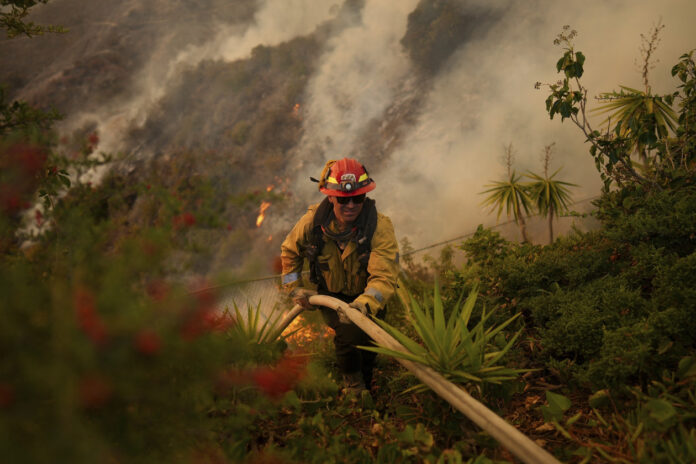As firefighters fought to contain the raging flames in the Los Angeles region, the death toll climbed to sixteen. The city’s most iconic monuments are in danger if the winds pick up speed and threaten to rekindle the flames.
The Los Angeles County coroner’s office released a statement on Saturday evening attributing five deaths to the Palisades Fire and eleven to the Eaton Fire.
While eleven deaths had been officially verified up until Saturday, authorities predicted the number would grow as cadaver dog teams searched flattened areas in a meticulous grid. A central location has been set up by the authorities for the purpose of reporting missing persons.
More residents were on edge as additional evacuation advisories were issued, and concerns were raised that winds may push the flames into the J. Paul Getty Museum and the University of California, Los Angeles.
The Palisades, Eaton, Kenneth, and Hurst flames had engulfed over 62 square miles by Saturday night, according to Cal Fire. This region is bigger than San Francisco itself. Fires in the Palisades and Eaton affected an area of 59 square miles.
More than 700 individuals sought safety in nine shelters, while 150,000 were ordered to evacuate Los Angeles County, according to a report published online on Saturday night by Michael Traum of the California Office of Emergency Services.
He said that more than 14,000 people, including just arrived Mexican firemen, are a part of the continuing response, which includes 1,354 fire engines, 84 planes, and crews from nine other states.
On Saturday night, Cal Fire reported that the Palisades Fire was 11% contained and the Eaton Fire at 15% contained. The battle is expected to go on.
The weather remains crucial, and Traum warned that another round of heavy winds is anticipated to begin on Monday.
On Saturday, helicopters doused the Mandeville Canyon fire with water as it roared downhill, igniting a furious struggle near the Pacific coast, where Arnold Schwarzenegger and other celebrities call home. As dense smoke enveloped the slope covered in chaparral, firefighters on the ground attempted to extinguish the raging flames using hoses.
On Saturday, CalFire Operations Chief Christian Litz stated that the Palisades Fire, which is raging in the canyon region near the UCLA campus, is a primary concern.
A flare-up on the Palisades Fire’s eastern flank prompted more evacuation orders on Friday night.
Strong Santa Ana winds may soon be back, according to the National Weather Service. There has been no major rainfall in over eight months, and the flames have been blamed for becoming infernos that devastated entire neighborhoods throughout the city. The winds have also played a crucial role in this.
The flames were threatening to leap across I-405, engulfing the heavily populated San Fernando Valley and Hollywood Hills.
More than 12,000 buildings have been destroyed by the flames that broke out on Tuesday, somewhat north of downtown Los Angeles.
North of Pasadena, the Eaton Fire has destroyed about seven thousand properties, including residences, apartments, companies, sheds, and automobiles. On Friday afternoon, firefighters made first headway in containing the blaze. Authorities issued further evacuation orders, but later revoked most of them.
Early estimates suggest the wildfires might be the most costly in the nation’s history, and the source of the worst flames has yet not been identified. Thus far, damage and economic losses have been estimated by AccuWeather to be between $135 billion and $150 billion.
People who had lost their houses rummaged through piles of donated clothing, blankets, and other household items as volunteers overwhelmed donation facilities, forcing some to be turned away. One such venue was the Santa Anita Park horse racing track.
According to Jose Luis Godinez, a native of Altadena, three houses that were inhabited by over twelve members of his family were leveled.
Speaking Spanish, he declared, “Everything is gone.” “Those three houses were our home, and now we’re homeless.”
Sheriff Robert Luna of Los Angeles County issued a warning to locals not to return to their burned houses in search of mementos.
People are driving all over the place, attempting to get in for no other reason than to look. Luna urged people to respect curfews and warned them to stay away.
On Saturday, officials issued a warning that the ash may include asbestos, lead, and arsenic, among other potentially dangerous substances.
Chris Thomas, a representative from the Palisades Fire’s unified incident command, cautioned that the substance was “toxic” and advised that inhaling it posed the risk of injury.
According to Thomas, residents will be able to return to their houses with safety gear once the damage assessment teams have finished.
In the midst of Los Angeles’s worst crisis in decades, Mayor Karen Bass is under intense scrutiny for alleged leadership shortcomings, political finger-pointing, and the launch of investigations.
On Friday, Governor Gavin Newsom directed state authorities to investigate the reasons behind the inaccessibility of a reservoir with a capacity of 117 million gal (440 million liters) and the dryness of many hydrants.
City officials, according to Los Angeles Fire Chief Kristin Crowley, let her department down by underfunding firefighting. She was also critical of the water shortage.
“When a firefighter approaches a hydrant, we anticipate the presence of water,” Crowley stated.
Devastation of this scale is shocking even for a state that experiences devastating wildfires on a regular basis. Officials from the state’s Office of Emergency Services have announced that anybody affected by the fires can submit an online application for urgent government relief.
